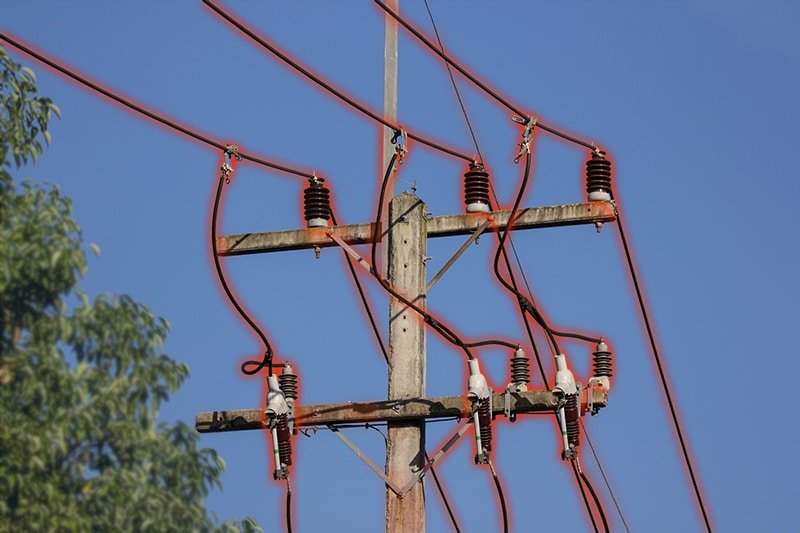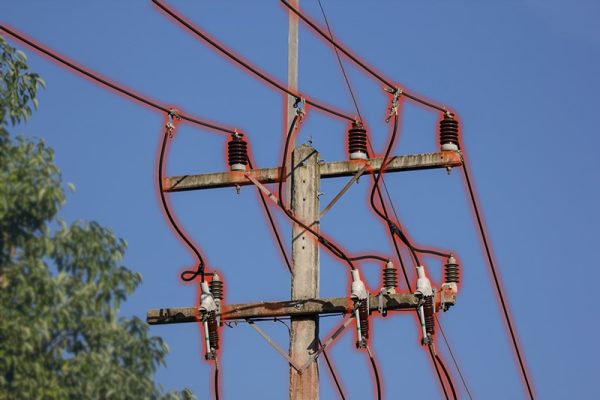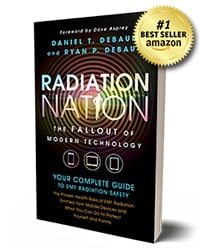Your cart is currently empty!

Power Lines and EMF: How AC/DC Power Emits ELF Radiation
Last Updated on October 4, 2023

Without electricity, our modern world would simply come to a halt.
More often than not, when you think of the “invention” of electricity, many people think of Ben Franklin. (Technically, he discovered it). His kite with the key experiment proved that lightning was electrical, thus jumpstarting (see what I did there?) the path to modern electricity, with power lines acting as the key vehicle to carry this power throughout the country.
A Short History of Power Lines and Modern Electricity
So how did electricity first get harnessed? Many other scientists built upon Franklin’s work. Michael Faraday figured out in 1831 that he could create an electric current by moving magnets inside coils of copper wire, called electromagnetic induction. This process is currently used—on a much larger scale—to create power.
Thomas Edison’s incandescent light bulb was the first practical use of electricity, powered by a small generator and patented in 1880, disrupting the existing gas lighting industry.
However, as electricity took over modern life, more power had to be generated and distributed. In 1882, General Electric was launched, and the first U.S. power plant was started in New York, called the Pearl Street Station. Houses throughout lower Manhattan were connected to the Pearl Street Station’s bank of generators by underground copper wiring. Reciprocating steam engines powered generators, which produced direct-current (DC) electricity.
DC didn’t last long as a means of electricity transmission; alternating-current (AC) electricity was created by Nikola Tesla in the 1880s, where currents could be transformed from low to high voltage and back, increasing transmission efficiency and allowing power to be carried for much farther distances. In 1893, the Niagara Falls Power Company worked with Tesla and the Westinghouse Corporation to harness the power of Niagara Falls and send it 22 miles away to Buffalo, New York. By 1911, AC grids spanned entire states.
Underground wiring also didn’t last long, although in many other countries underground wiring is used. For the expanse of land in the U.S., it was too expensive and just wasn’t practical.
Now, high-voltage power lines stretch for over 200,000 miles across the U.S., which could wrap the Earth more than 8 times! These power lines move electricity from power plants to local distribution systems, which deliver it to your home. They convert power from 69,000 to 765,000 volts for more efficient transmission, then back down to 120-240 volts for use within your home.
In the U.S. there are only 3 main AC grids. The Eastern Interconnection, the Western Interconnection, and the Texas Interconnection, which doesn’t even cover all of Texas. Each interconnection represents synchronized machines—considered the largest machines on the planet!—that hum at 60 hertz (Hz).
Power lines are everywhere these days, bringing electricity to our homes, schools, and businesses—but what does that mean in regard to exposure to EMF radiation?
How do Power Lines Emit EMF Radiation?
Well, power lines are exactly what they sound like. They are lines of wires that carry power, or electricity. Unlike WiFi, they do not send wireless RF (Radio Frequency) radiation signals through the air.
With no RF signals to worry about, power lines still emit radiation, known as ELF, or Extremely Low Frequency Radiation.
ELF radiation represents the leak of energy in anything that carries or operates with AC or DC power. In an AC transmission line, the bare wire conductors are usually made of copper, aluminum, and sometimes reinforced with other materials, carrying the power through the lines.
However, the resistance of the line itself results in a fractional loss of power as the power travels down the cable. The longer the cable, the more power is lost. There are also losses in the metal surrounding the cable and the insulation surrounding the cable, which is never perfect at insulating all power. Typical power losses for conventional transmission cable are estimated to be about 30 to 40 W/m.
Is ELF Radiation Safe?
Many people forget about ELF, and only worry about the RF signals coming from your Wi-Fi routers, your cell phones, or your wireless earbuds.
That being said, generating, transmitting, distributing, and using electricity all expose us to ELF radiation. From power lines to any device with a plug or battery, including your hair dryer, alarm clock, and electric blanket, ELF radiation can have a biological effect on your body if the levels are high enough, or if exposure time is long enough. Fields decrease rapidly the farther away you are, so you have to be pretty close to experience potential biological effects.
Tissue heating and nerve stimulation are well understood effects of ELF at high field strengths, and used for public exposure standards. However, even low field strengths from electric appliances and power lines can affect your body if you are close enough and exposed for a long period of time.
The main concerns that have been found to be associated with exposure to ELF include:
- Cancers such as childhood leukemia, cancer of the central nervous system, and lymphoma
- Reproductive and developmental effects
- Neurobiological effects like learning and behavioral issues
From the epidemiological studies showing these effects, the International Agency for Research on Cancer (IARC) classified extremely low frequency magnetic fields as possibly carcinogenic to humans (category 2B) in 2002. The results of these studies indicated that prolonged exposure to relatively high levels of magnetic fields (3-4 milligauss), increases the risk of developing leukemia by a factor of 1.5-2.
The magnetic fields immediately under distribution lines are around 5 mG, but can reach up to 50 mG in densely populated areas.
Are Power Lines Safe?
Research shows that exposure from power lines is minimal because the majority of the time, you simply aren’t close enough to the power source. The farther you are from the source, the weaker the EMF radiation. While RF can travel wirelessly through the air, ELF is a by-product of electrical currents, with most being low power level source emissions not traveling far.
Power lines are either buried underground (although typically not in the U.S.) or at the top of utility poles—other wires may be other communication lines such as television, internet, and phone. Industry standards, set by the 2020 National Electrical Safety Code, dictate the standard height of a utility pole to be 35 feet. High voltage lines—the big powerline towers—are much higher than 35 feet, and range anywhere from 50 to almost 200 feet tall.
The National Institute of Environmental Health Sciences provides this example: “a magnetic field measuring 57.5 milligauss immediately beside a 230 kilovolt transmission line measures just 7.1 milligauss at a distance of 100 feet, and 1.8 milligauss at a distance of 200 feet”. Put simply, at 100 feet away from the power line, the magnetic field decreased by 87.7%, and at 200 feet, it decreased 96.9%.
For residential areas, transmissions lines have an average voltage of 120 to 240 volts, so the strength of the magnetic field may be even lower than the above example.
Are Power Lines a Daily Source of EMF exposure?
Generally, you are at a safe distance from power lines. According to the Australian Radiation Protection and Nuclear Safety Agency (ARPANSA), homes that are 50 meters away from a high voltage power line don’t have higher than normal exposure levels. Homes that are 5 to 10 meters from substations and transformers have “indistinguishable” differences compared to typical household levels. To compare, standing under a power line would be similar to being a foot away from an alarm clock. Both average about 5-10 mG.
If you are living above underground power lines, the earth that surrounds the embedded lines absorbs some of the harmful radiation, decreasing the amount of EMF radiation that actually reaches you.
Additionally, more and more power lines are being built underground and with nano carbon tube shielding. Power lines need to have shielding to prevent electromagnetic interference with each other. Nano carbon tubing is the latest technology to help keep electromagnetic radiation within the power lines and help prevent leakage. While the main purpose of this tubing is to prevent electromagnetic interference between the lines, it also benefits your health by reducing your exposure to radiation from power lines.
While power lines do emit EMF radiation, there are many other appliances and electronics you use everyday in your home that emit similar or higher levels of ELF fields. However, these fields drop off so quickly that as long as you aren’t making direct contact with these appliances, usual daily interactions with electronics should not be too concerning. Using high-powered devices, like a large laptop, on your lap for multiple hours every day should be avoided. Sleeping with a phone charger and phone under your pillow is also ill-advised. If you are EMF hypersensitive, pregnant, or have an immune disease or illness, you should be more mindful of the electronics you come into close contact with daily. From electric blankets, to computers, to your hair dryer, you can always check with a gaussmeter to make sure your exposure is below 4 milligauss, which is the recommended limit by the EPA.
Ways to Limit ELF Exposure
- Limit direct contact with electronic devices. This includes your smart devices like your iPhone and tablet, but also your television, desktop computer, refrigerator, alarm clock, and electric blankets. Ideally, keep electronics 1-4 feet away.
- Keep electronic devices out of your bedroom. This can create a sleep sanctuary that will benefit your sleep and body recovery in multiple ways.
- Unplug devices when you are not using them. Even if a device is off, if it is plugged in, it will still create an electromagnetic field since AC power will still be flowing through the device.
- Smart meters expose you to ELF more than power lines do. However, even regular electric meters expose you to ELF (regular meters do not emit RF). This is because a meter is usually located on the exterior wall of your home. Make sure the location of your electric meter is not on the wall of your bedroom closest to your bed. If you are EMF sensitive, you might need to move your meter to another location.
- Most shielding products do not include protection from ELF fields. This is due to their extremely long wavelength that cannot be blocked by fabric-like materials that incorporate conductive metals. A more rigid substrate needs to be used. DefenderShield’s Signature Shielding Technology includes ELF protection in addition to RF protection, and is used in our laptop shields, tablet cases, and phone wallet cases.
Related Posts
None found



























